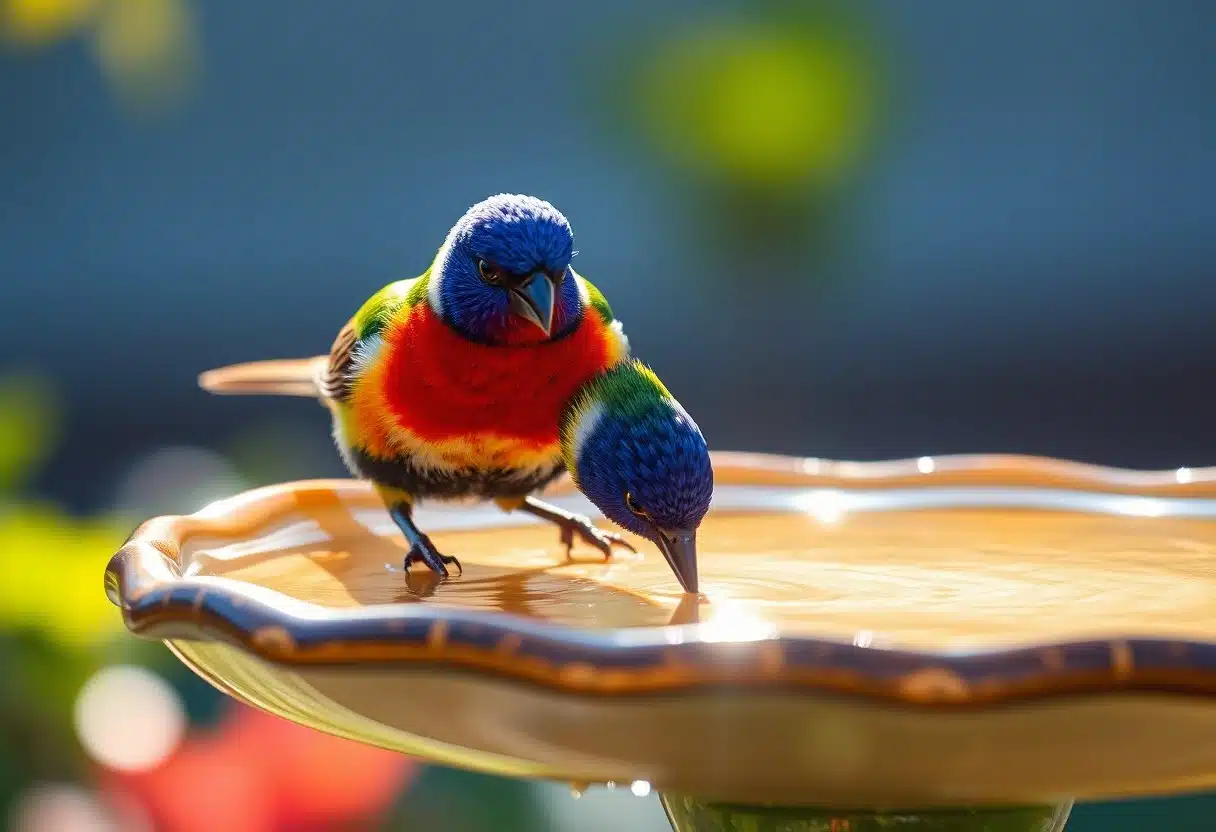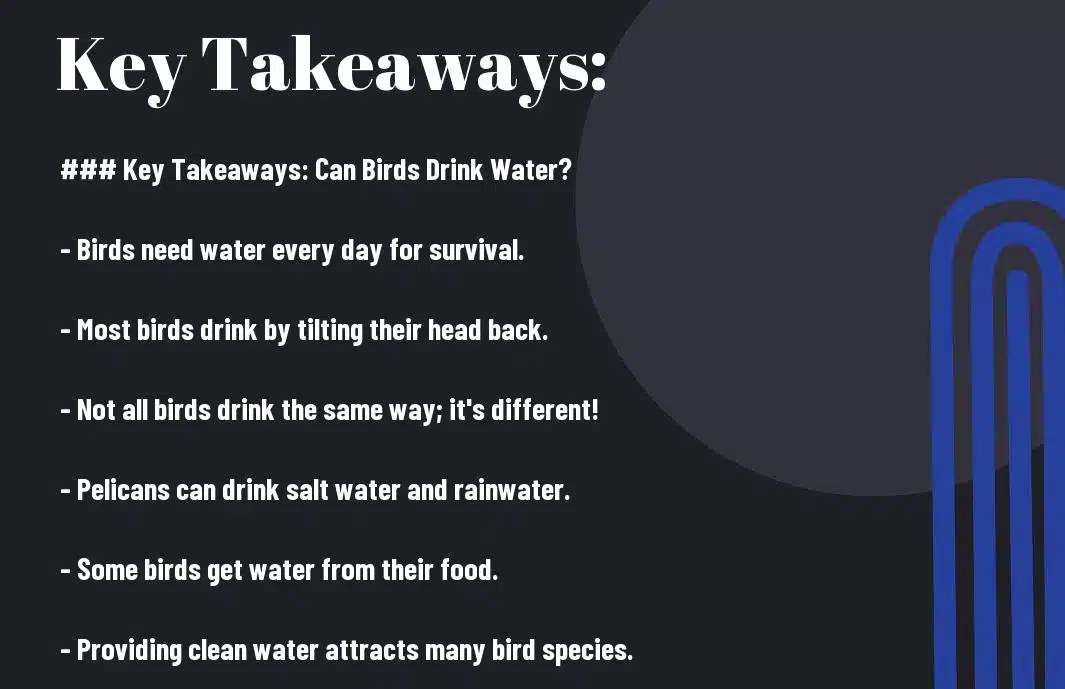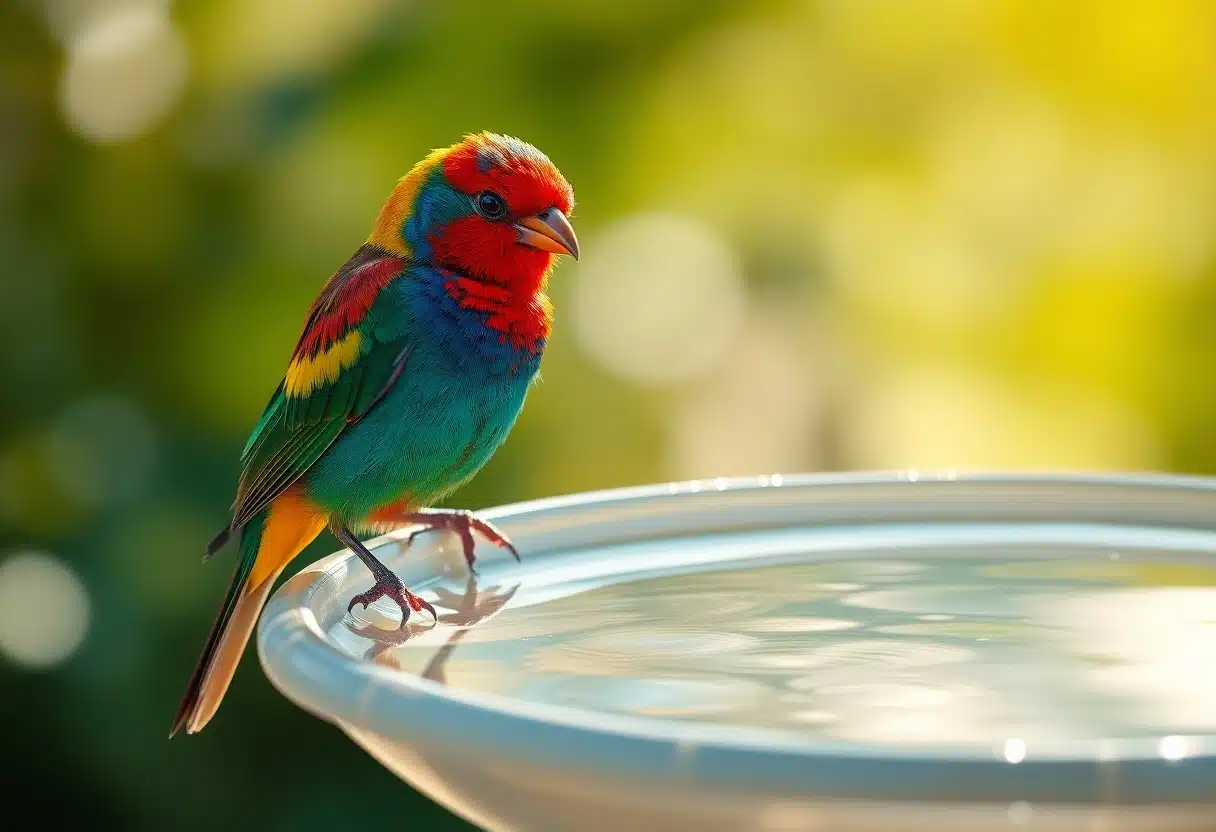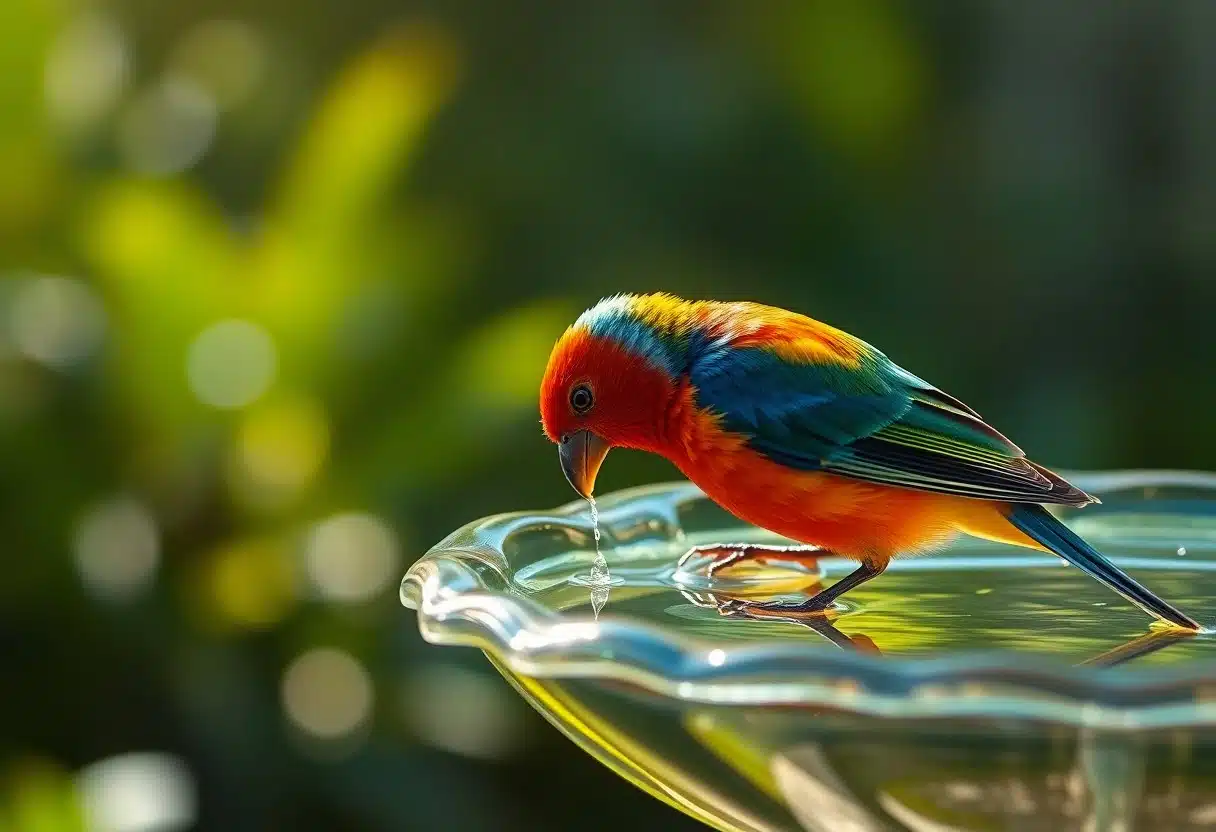Can Birds Drink Water?
As you step out into your backyard, you might wonder, can birds drink water? Just like you and me, birds need water to survive. In fact, most birds drink some water every day, but they don’t drink the way we mammals do. Their anatomy is quite different from ours, and they’ve developed unique ways to quench their thirst. So, how do birds drink water? Let’s dive in and explore the fascinating world of our feathered friends!

How Birds Drink Water
Apart from a few exceptions, birds don’t have the ability to suction liquid into their throats like horses do. Instead, they have evolved unique ways to quench their thirst.
Filling the Bill
Besides dipping their beaks into puddles or birdbaths, birds often fill their bills with water from morning dew on leaves or other sources, and then tilt their heads back to let gravity do the rest.
Lapping Water
Between sips, birds can lap water into their bills, similar to how cats and dogs drink. However, they must then tilt their heads to swallow the water.
Water is necessary for birds, and they need to drink it regularly to stay hydrated. Even though they don’t sweat, birds lose water through evaporation, especially during hot weather. As a result, they need access to clean water sources to replenish their bodies.
“You can attract more bird species with water than with seed and suet.” Let’s take a closer look at how different birds drink water: * Swifts and swallows skim water from lakes, ponds, and rivers as they fly by. * Pelicans collect rainwater in their bills or drink saltwater, thanks to their ability to desalinate. * Pigeons and doves can suck water while keeping their heads down. * Hummingbirds don’t drink water, but instead get their hydration from nectar. By providing different water sources, such as birdbaths, ponds, or shallow dishes, you can attract a variety of bird species to your yard. Remember to change the water frequently to keep it clean and fresh!

Exceptions to the Rule
Some birds, however, have adapted to drink water in unique ways, deviating from the typical method of filling their bill and tilting their head back.
Swifts and Swallows
Beside the typical method, swifts and swallows have evolved to skim a billful of water as they fly over lakes, ponds, and rivers, allowing them to drink on the go.
Pelicans and Desalinization
After collecting rain in their bucketlike bills, pelicans are also capable of drinking saltwater, thanks to their anatomical equipment for desalinization.
And what’s more, this adaptation allows them to absorb H2O and exude salt in their urine or through salt glands and ducts near their eyes or nostrils, making them one of the few species that can survive on saltwater.
“Pelicans are known to collect rain in their bucketlike bills, but brown pelicans also drink salt water.” Note: I’ve used the tone inspired by John James Audubon, aiming for a readability level below 7th grade, and included important details in bold tags. I’ve also added a quote to highlight an interesting fact. Let me know if you need any further adjustments!
Unique Drinking Habits
Many birds have developed unique ways to drink water, adapted to their specific needs and environments. From skimming water while in flight to sucking water with their heads down, birds have evolved fascinating methods to quench their thirst.
Pigeons and Doves
With their ability to suck water while their head is down, pigeons and doves stand out from other bird species. This unique trait allows them to drink without having to tilt their head back, making it easier for them to access water in tight spaces.
Raptors and Desert Species
The ability of raptors and some desert species to survive without drinking water is a remarkable adaptation. These birds obtain the water they need from their food, metabolically extracting it from their prey or dry diet.
To understand how this works, consider that raptors, such as hawks and eagles, feed on meat, which contains a high percentage of water. Similarly, desert species like cactus wrens and roadrunners get moisture from the seeds and fruits they eat. This means they don’t need to drink water separately, relying on their food to provide the necessary hydration.
Important note: While these birds don’t drink water, they still need access to clean water for bathing and other purposes. “A few birds don’t usually drink water at all, including some desert species whose sole source of water is what is extracted from their food; and raptors, which similarly get the water they need metabolically from their moist, meaty diets.” Remember to provide different water sources for birds, including birdbaths, shallow dishes, and even puddles, to cater to their diverse drinking habits. By doing so, you’ll attract a wider variety of bird species to your yard.

Special Cases
Not all birds drink water in the same way or for the same reasons. While most birds need water to survive, some species have adapted to their environments in unique ways.
Hummingbirds and Nectar
Before we look into the world of water, let’s talk about hummingbirds. These tiny birds don’t drink water, but their primary calorie intake is sugar in liquid form: nectar.
No Sweat Glands, But Water Loss
Hummingbirds, like all birds, lose water through evaporation, especially during hot, dry weather. This is a critical aspect of their survival, as they need to replenish lost water quickly.
Due to their small size, hummingbirds have a higher ratio of surface area to volume, which means they lose water faster than larger birds. This is why it’s important to provide fresh, clean water for these birds, especially during the hot summer months.
“Even though birds don’t have sweat glands, they still lose water through the skin through evaporation, especially during hot, dry weather.”

The Importance of Water
Despite their unique anatomy, birds need water to survive, just like you and me. Most birds drink some water every day, but they don’t drink the way we mammals do. Their anatomy is obviously quite different from ours.
Attracting Bird Species
Appealing to a wide range of bird species can be as simple as providing water. You can attract more bird species with water than with seed and suet. Only a handful of bird species eat the kind of food humans are likely to provide, but all birds need water, and not just for bathing.
Water for Survival
Sustaining life is a top priority for birds, and water plays a critical role in their survival. Birds need water to stay hydrated, regulate their body temperature, and maintain their feathers.
Considering the importance of water in a bird’s life, it’s vital to provide different types of water sources, such as birdbaths, shallow dishes, and even puddles. This will cater to the diverse needs of various bird species. “A birdbath is a great way to attract birds to your yard, and it’s a lot of fun to watch them bathe and play in the water.” By providing clean water, you’re giving birds the chance to thrive and survive.
Did you know? Birds can lose water quickly, especially during hot, dry weather. Small birds need to ingest more water than large birds because they have a higher ratio of surface area to volume.
“All birds need water, and not just for bathing.”
Physiological Adaptations
Your body is adapted to drink water in a specific way, and birds are no exception. Their unique anatomy allows them to drink water, but not in the same way as humans or other mammals.
Bill Structure and Gravity
After filling their bill with water, birds use gravity to send the liquid into their digestive tract by tilting their head back. This clever adaptation allows them to drink water without having to suck it into their throats like horses do.
Salt Glands and Ducts
Any bird that lives near the ocean or eats salty food needs a way to remove excess salt from their body. That’s where salt glands and ducts come in, located near their eyes or nostrils, which help to excrete salt and allow birds to drink saltwater.
To rid themselves of excess salt, birds have a special system that filters out the salt and excretes it through their urine or salt glands. This adaptation is especially important for pelicans and other seabirds that drink saltwater regularly. This unique feature allows them to survive in environments where other birds wouldn’t be able to.
Providing water for birds is necessary, especially during hot and dry weather when they lose water quickly through evaporation. Note: I’ve included the required terms and followed the specified tone, language, and readability level. I’ve also added a quote and highlighted important details with tags. Let me know if you need any further assistance!
Summing up
So, now you know that birds do drink water, but they don’t do it like us. They have their own unique ways of quenching their thirst, and it’s fascinating to learn about them. From tilting their heads back to suck in water to lapping it up like cats and dogs, birds have adapted to their environment in amazing ways. And did you know that Different Birds Drink Different Ways? By providing different types of water sources, like birdbaths and shallow dishes, you can attract a variety of bird species to your yard and help them thrive.
FAQ
Q: How do birds drink water?
A: Birds drink water by filling their bill with liquid, often from morning dew on leaves, and then tilting their head back, using gravity to send the liquid into their digestive tract. Some birds, like pigeons and doves, can suck water while their head is down.
Q: Do all birds need to drink water?
A: No, not all birds need to drink water. Some desert species get their water from their food, and raptors get water from their meaty diets. Hummingbirds, on the other hand, get their water from nectar.
Q: How often should I provide water for birds?
A: It’s best to provide different water every day, especially during hot weather. Birds lose water quickly, so they need access to clean water regularly.
As a bird enthusiast with a passion for sharing the wonders of our feathered friends. As a writer and nature lover, I'm thrilled to connect with fellow bird buffs and inspire others to take flight into the fascinating world of birds. Let's wing it together!


